My brothers and sisters in Christ, thank you for coming to visit my blog. I have had a very busy week, especially with the episcopal ordination of two of the Archdiocese of Boston�s parish priests. I am sure you have been busy as well during this preparatory time of Advent.
The feast of Our Lady of Guadalupe on Dec. 12 was a wonderful time for us to be celebrating the ordinations of the new bishops. It�s a very “Advent” feast. It�s Our Lady of Advent, Our Lady who is carrying the Christ child in her womb and who told Juan Diego to tell the bishop that she wanted him to build a church.
We had over 3,000 people in the cathedral. It was packed! There were 400-500 priests, about 40 bishops, many choirs and there was such a spirit of joy in the community.
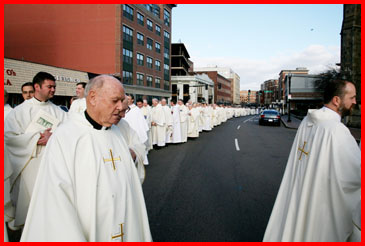
�The line of priests processing into the Cathedral stretched down the block
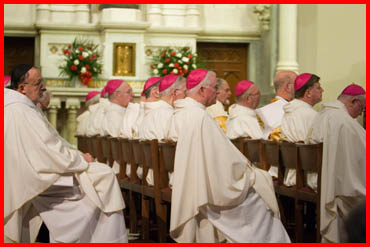
The bishops who attended the ordination

As you can see, the Cathedral was packed
Having a large number of Hispanic parishioners and a large number of the youth representing the parishes of Bishops Hennessey and Dooher brought a great energy to the celebration. Many of the youth were from St. Mary Parish�s Life Teen program in Dedham, where Bishop Dooher had served as pastor for a decade. The parish has done an extraordinary job with the Life Teen program, sending over 100 youngsters to World Youth Day in Germany last year. They are also looking forward to sending a group to Sydney for the next World Youth Day. The program is an important way of involving young people in the life of the Church and preparing peer ministers.
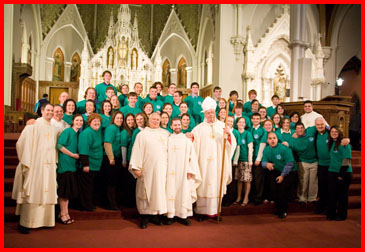 �
�
Bishop Dooher poses with his LifeTeen group
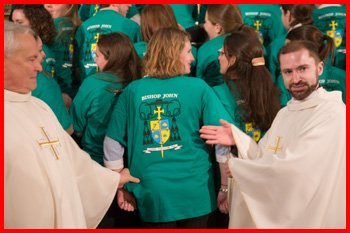
Showing of their “Bishop John” t-shirts
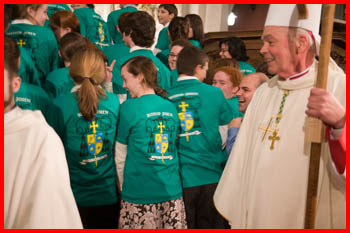
Bishop Dooher seemed amused by them
The ordination was very beautiful, both visually and aurally. We�re very grateful to Leo Abbott and the choirs for the music, which was very uplifting. The procession was headed up by an image of Our Lady of Guadalupe. Some of the parishioners from Most Holy Redeemer Parish in East Boston, where Bishop Hennessey was pastor for 12 years, carried the traditional roses to be placed in front of the image in the sanctuary.
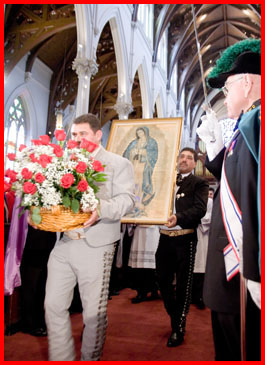
The roses and the image of Our Lady
The symbols of the bishops were also carried up in procession by a number of priests, including the bishop�s rings. The bishop�s ring symbolizes his marriage to the Church. I had never worn a ring in my life before my episcopal ordination. I suppose like someone who puts a wedding ring on, it�s very significant. It�s something that�s a constant reminder of one�s vocation and mission in the Church. The ring that I wore was one that my father gave me, and it�s a simple silver band. Inscribed on it are Mary�s last words in the Gospel, �Quodcumque dixerit facite� or �Do whatever He tells you.� When I was given the ring I am wearing now by the Pope Benedict XVI for my elevation to cardinal, I had the same words printed on here.
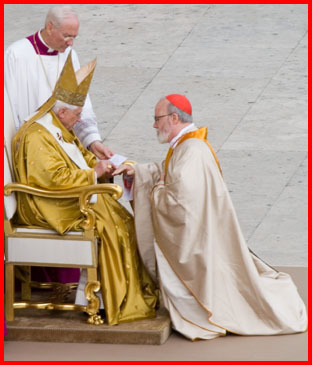
The Holy Father places the ring on my
finger for my elevation to cardinal
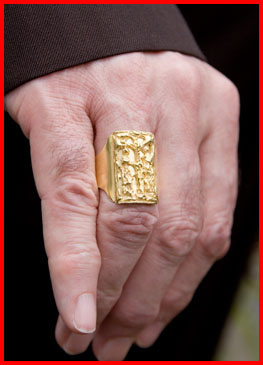
A closer view. The image is the crucifixion with His mother and St. John below the cross
I spent a good deal of the homily talking about the importance of the ring of a bishop and more specifically the significance of Bishops Dooher and Hennessey�s rings. Following is the text of my homily as well as my comments directed to the Hispanic community:
My brother bishops, priests and deacons, fellow religious, seminarians, knights and ladies, friends, families, parishioners of our newly appointed bishops, visitors and very dear friends, it�s such a joy to welcome all of you to the Cathedral of the Holy Cross for this ordination.
We are pleased to be joined by leadership from our fellow Christian churches, our Jewish brethren and representatives from the Muslim community. I would like in a special way to welcome His Eminence Metropolitan Methodius of the Greek Orthodox Diocese and Rev. Dr. Diane Kessler, the executive director of the Massachusetts Council of Churches. The ecumenical and interfaith community blesses us with their presence here today.
Last evening in the chapel at the rectory, it was my happy privilege to witness the oath of fidelity and profession of faith of our new bishops. They were required to do this in Latin. Now one of them was a graduate of Boston Latin School. I won�t comment on their pronunciation, but it reminded me of a story of a former bishop of mine, Cardinal O�Boyle. When I was a priest in Washington, he told of going to the opening of the Second Vatican Council. He took a young Jesuit Latinist with him. The bishops were sitting in the nave of St. Peter�s, 3,000 bishops from all over the world, and Blessed Pope John XXIII, Holy Pontiff, came in procession wearing the tiara and all of the pontificals and solemnly opened the Second Vatican Council, �In nominee Patris et Filii et Spiritus Sancti. Amen.� The Jesuit leaned over and said to Cardinal O�Boyle, �That means, �In the name of the Father and of the Son and of the Holy Spirit.��
But I�m sure that Bob and John feel the way that I do. Had we known we were going to be bishops, we would have studied much harder in the seminary. I imagine that nowadays there are few seminarians aspiring to the episcopacy since it was established that one of the indelible marks of the sacrament is a bullseye that they tattoo on your back.
We are so happy to be here today. I can attest to the fact that these men were so surprised and overwhelmed by the news of their appointment as bishop. We are all very gratified by the enthusiastic response of the people of the archdiocese, especially by their fellow priests and pastors. That should give you great confidence as you accept this responsibility to this vocation to serve as a bishop in the Archdiocese of Boston.
We are so grateful to our Holy Father Pope Benedict for naming two fine priests to serve the archdiocese as our auxiliary bishops. Father John Dooher and Father Bob Hennessy have shown themselves to be true pastors who have served their people with a deep faith and pastoral love. We know that their talents and goodness will help us in our ministry to God�s people in the face of many challenges.
And I know that I am expressing the sentiments of all our Catholics as I acknowledge the outstanding service rendered by Bishop John Boles who is poised to enjoy a well-deserved relief from administration but who will continue to serve us all with great love and compassion.
Four hundred and�seventy five�years ago there were very few Catholics in the Western Hemisphere, and the evangelization of the New World was stalled. Some of those who came from Europe thought that the native populations were simply to be exploited. There were many good missionaries who were frustrated that many cruel and greedy people, claiming to be Christians, gave religion a bad name. Reminds one what Gandhi once said, �If I had ever met a Christian, I would have become one.�
The scandal of violence and greed made evangelization seem an impossible task, but as the Gospel reminds us, �Nothing is impossible for God.� Suddenly, everything changes. The Mother of God appears. She�s clothed in the sun, the stars on her mantle, the moon at her feet. She comes not as a grand European se�ora but as an Indian, an indigenous woman. As the tilma that you see here on our image of Our Lady of Guadalupe shows, she is wearing a black belt. This is not to indicate some level of proficiency in the martial arts. This was the Aztec maternity dress. The Virgin is pregnant. She is the woman of Advent, Mary of the Visitation, a living tabernacle carrying Christ to the world.
Mary is the woman of the Apocalypse. God�s temple in heaven was opened, and the Ark of the Covenant could be seen as we heard in the second reading. In the Litany of Loreto, we call Our Blessed Mother the Ark of the Covenant. In �The Raiders of the Lost Arc,� Indiana Jones is searching for the lost treasure of ancient Israel. Even Hollywood recognizes what a spiritual treasure the Ark of the Covenant is for God�s people.
The spirit of God hovered over the Ark of the Covenant that contained Israel�s treasures: the tablets of the law, Aaron�s rod and the manna, the mysterious bread from heaven. Israel carried the Ark of the Covenant in their sojourn in the wilderness, into battle and around the walls of Jericho, which came tumbling down. When the Philistines captured the ark and brought it into their camp as the spoils of victory, their great idol fell before the ark and was smashed into smithereens. In today�s Gospel, Luke�s account of the visitation, Mary is presented as the Ark of the Covenant. John the Baptist in Elizabeth�s womb leaps with joy, like King David dancing before the Ark of the Covenant. The Book of Chronicles says the ark stayed at the home of Obededon for three months and so Mary spent three months in Elizabeth�s house.
The Ark of the Covenant is still accompanying God�s people in the person of Mary. She makes God�s presence felt. She guides and protects us. She models for us the life of discipleship.
The Gospel tells us that when John the Baptist in his mother�s womb heard Mary�s greeting, he leapt for joy. We too rejoice when we hear Mary�s words.
In Mexico, in a time of crisis for the people, for the Church, Our Lady of Guadalupe appears, and a new people are converted to the Gospel, not by the sword but by beauty. When Juan Diego encounters the beautiful woman, he hears music, he smells flowers. All of his senses are overwhelmed by beauty. As Dostoyevsky writes in �The Idiot,� �Beauty will save the world.� What is most beautiful about the lady is her love for the poor Indian, Juan Diego, the beauty she reflects in God�s merciful face.
In the Gospels, the protagonists are the little ones, the poor, the shepherds, the fishermen, prostitutes, the lepers, the blind, the lame and the halt. Jesus takes those on the fringes of society and brings them center stage. His Mother follows the same program. In ancient Rome, when the deacon Laurence was asked by the Roman Emperor to show him the Church�s treasures, the holy deacon took to the Emperor, the orphans, the poor, the sick. �These are the Church�s treasures,� he said.
Today in this ordination ceremony, you Bob and John will make a promise to be welcoming and merciful to the poor, the strangers and those in need � in other words, to care for the Church�s treasures.
Juan Diego was one of those treasures, poor in the eyes of the world but rich in faith. Like John the Baptist in the visitation story, Juan Diego also lept for joy at the sound of Mary�s beautiful voice. Through her the pains and scandal of conquest are transformed into the joy and glory of a new life, the life of faith. Mary makes Juan Diego, a poor illiterate Indian, her envoy and messenger. We can only imagine his sense of hesitancy and inadequacy.
I am sure that our new Bishops experience that sort of feeling as they are being called to new responsibilities in the Church today. Like Juan Diego with simplicity and trust you embrace the challenge. It is not for yourselves but for the good of others.
Mary has a message for the bishop, Fray Juan de Zumarraga. He was a Franciscan friar, a great defender of the Indians who had smuggled letters out of Mexico to the king of Spain to report on the abuse and exploitation of the indigenous population. It is curious though, Mary does not speak directly to the bishop but sends a layman with a message. Mary wanted the Bishop to build her a church, a home where she could gather her children into one family. As a sign, she sent roses, roses in December and the beautiful image of herself on Juan Diego�s poncho. Scientist have studied the tilma and can find no scientific explanation. �For those who believe, no explanation is necessary, for those who do not believe, no explanation is possible.�
God�s love is like roses in December, full of surprises. When we least expect it, in season and out of season, God�s love is there for us.
Roses in December resulted in a whole new people who had been largely turned off by their first contact with Christians. Now they were able to give the Gospel a new chance. Today, we speak often about the new evangelization. Our challenge is to invite people to look at the Gospel again, to give the Gospel another chance and to discover in Christ�s message the answer to all our aspirations. We often feel that we are inadequate messengers, but we are the ones God has called to do this � to show the roses in December to a world grown cynical and cold. Pope Benedict�s first encyclical captures our message: God is love. Everything we do must be motivated by love, otherwise it is unworthy of the Gospel. Only love brings roses in December.
Mary�s message to the Bishop is, �Build my Church, make me a home where I can gather all of my children together.� They sound like Christ�s words to Francis, �Rebuild my Church.� Juan Diego, Bishop Juan de Zumarraga, the faithful Christians, Spaniards, meztizos and indigenous accepted Mary�s challenge and built, not just a shrine where millions go on pilgrimage, but built up a Catholic people and culture ready to share the joy of the Gospel with all. Soon, virtually the whole country had embraced the faith, and Mexicans were leaving their homeland to take the message of the Gospel to the ends of the earth. The first Mexican saints died as martyrs in Nagasaki in 1597.
In the early 16th century, the first missionaries arrived in Japan. Soon there were as many as two million Catholics in that country, but a terrible persecution broke out. In many places the Shoguns made what are called fumies, large medallions with pictures of Christ and the Blessed Mother. These fumies were placed on the ground, and the population of a village would be lined up and invited to tread on the fumies. If anyone refused, they were tortured to death. The Church survived underground for 200 years in Japan. People lived their faith in secret, waiting for the priest to return. They lived with one sacrament, baptism, all the while longing for the Eucharist. In 1865, a French missionary, Father Petitjean, discovered these underground Catholics, the legacy of the martyrs.
A couple of years ago, an Augustinian friar from Merrimack, Father Bill Garland, gave me a replica of one of those fumies from the 16th century, which he brought me from a parish in Japan. I was very moved by the story of the early Japanese martyrs who suffered for their new-found faith, but I was also quite struck by the fact that the medallion the martyrs were asked to trample was an image of Our Lady of Guadalupe. It is a reminder that the Virgin�s request to build a Church resulted in missionaries from Mexico going to far off countries to shed their blood and to share our Catholic faith.
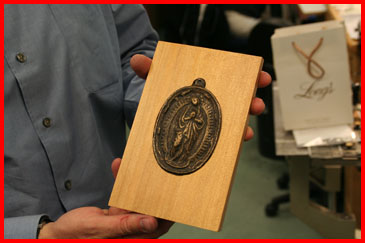
The fumier used as a model for the new bishops’ rings
The rings that I shall present to our new bishops bear an image of the old Japanese fumie of Our Lady of Guadalupe. When we kiss this image on their rings, we should remember that many of our brothers and sisters in the faith long ago in Japan died rather than tread on this image. In a world where many people are quick to put aside their faith for personal convenience, political expediency or to be comfortably assimilated into the dominant, secular culture, let us remember those martyrs who died courageously with Jesus� name on their lips to encourage us to live a life of fidelity even in the most hostile circumstances.
Father Dooher and Father Hennessy, the fumie of Our Lady of Guadalupe is the image on your bishops� rings. I am grateful to Bob Rothenberg, my friend, for making these rings for today�s ordination. May they inspire you to be generous and courageous in your ministry and in your service to God�s people. And may Mary, the Mother of the Divine Shepherd, bless your ministry to build up the Church.
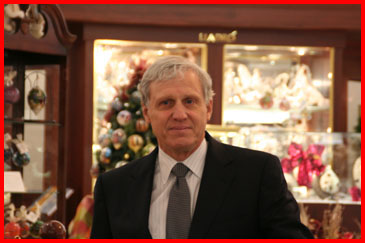
Bob Rothenberg
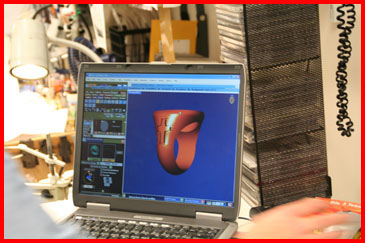
The rings were designed on a computer before they were produced
In the whole New Testament, there are only two references to the word ring, unlike the Old Testament where rings are constantly mentioned. The first reference to a ring is in the parable of the prodigal son, where the repentant son returns home, dirty and dressed in rags. His father kisses him, gives him new clothes and puts a ring on his finger. The only other New Testament mention of a ring is in the Epistle of St. James, where the author warns against being too impressed by a man with gold rings on his fingers and fine clothes. Such a person, St. James warns us, should not be given preference over the poor man who is rich in faith and who loves the Lord.
Since the early Church, the ring has been a sign of a bishop�s betrothal to his Church. When the king of Spain was conferring a high honor on the writer Miguel de Unamano, he noticed how nonchalant Unamano was about the honor he was receiving, so the King commented, �Every other person who has received this honor protested that they were not worthy.� To which Unamano responded, �And they were right.�

I place the ring on Bishop Hennessey’s finger…
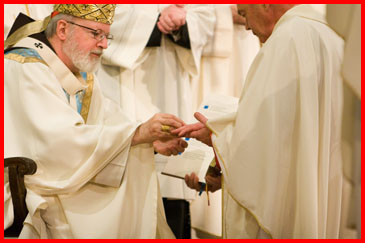
… and on Bishop Dooher’s
I know that every man called to be a bishop feels like the prodigal son who said, �Father, I am not worthy to be called your son.� Yet today you will receive new clothes, a kiss and ring on your finger. The call to ministry is a call to ongoing conversion, to live in the Fathers� House and to work in His vineyard.
Wear the ring with the humility of the prodigal son and with the love of a bridegroom who is totally devoted to and madly in love with your Bride, the Church. As the ritual reminds us, the title of bishop is one of service, not of honor. The ordination ceremony cites the words of Christ that the greater should behave as the least and the ruler as the servant.
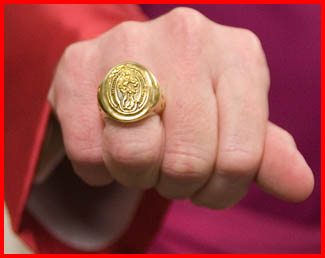
A close-up of Bishop Hennessey’s ring
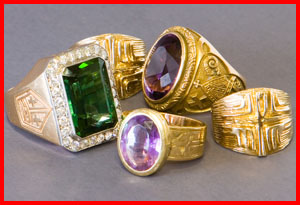
Some historical bishops’ rings from the Archdiocese’s archives
This ordination ceremony assures us that Christ is keeping His promise that He will never leave us orphans. The unbroken succession of bishops that Christ began in the apostles is preserved from generation to generation by the laying on of hands so that the sacraments will be available to believers in every age. Without bishops, there would be no Eucharist, and the priesthood would die out. Without bishops, God�s people would be deprived of the Mass where Jesus makes a gift of Himself in the new manna, the living Bread, His Body and Blood. The voice of the Good Shepherd continues to be heard in the teaching office of the bishops who announce the good news in season and out of season. �He who hears you, hears me,� Jesus says. The bishop is called to lead God�s people on their earthly pilgrimage toward eternal happiness. With a sense of our inadequacy but trusting in our loving God, we stand united with our brother bishops of the Church and our Holy Father, Pope Benedict, who wears the fisherman�s ring.
With our priests and people, with our religious and deacons, we work to build God�s House, the Church, and joyfully show the world that God�s love is full of surprises, even roses in December.
Al Pueblo Hispano quisiera dirigir una palabra de saludo en castellano. El Adviento comienza con las grandes fiestas marianas de la Pur�sima y de la Guadalupana Mar�a es la mujer del Adviento. Como nos cuenta el Evangelio de hoy, el ni�o Juan el Bautista a�n en el vientre de su madre Isabel salt� de alegr�a al sentir la voz de Mar�a. Nosotros tambi�n nos emocionamos al cantar las ma�anitas a nuestra Madre y escuchar sus palabras: �Haced lo que El os diga,� que es el perenne mensaje de Mar�a. Ella siempre nos acerca a su Hijo Jesucristo. Ella nos ense�a ser disc�pulo fiel de nuestro divino maestro. La Virgen de Guadalupe pidi� a Juan Diego y al obispo Fray Juan de Zum�rraga hacer una Iglesia. Hoy nos renueva ese pedido. Que hagamos una Iglesia bella y unida, que refleja la mansedumbre y bondad.
De la Virgen, el coraje de los m�rtires, la generosidad de matrimonios sacrificados y fieles y ejemplo de los confesores y v�rgenes entregados al servicio del Reino.
Jesus fund� la Iglesia sobre los cimientos de los doce Ap�stoles que eran los primeros obispos. Hoy al consagrar estos dos obispos nuevos nos llenaremos de agradecimiento por Cristo porque no nos ha dejado hu�rfanos.El buen Pastor env�a ministros a servir su reba�o y apacentarlos con la Palabra de Dios y los Sacramentos. En la Iglesia cat�lica hemos conservado por dos mil a�os la sucesi�n apost�lica. En los hechos de los Apostoles San Lucas narra como la Iglesia escoge a Mat�as para reemplazar a Judas. As� empez� una cadena continua de ordenaciones sin interrupci�n desde el tiempo de los Ap�stoles hasta el presente, garantizando que los sacramentos sean presentes, sobre todo la Eucarist�a, hasta el fin del mundo.
Alabado sea nuestro Dios cuyo amor nunca nos faltar�.Gracias por su fe, por su bondad, por su presencia aqu�.�Que viva la Virgen de Guadalupe!
�Que viva la Iglesia Catolica!
�Que vivan nuestros flamantes obispos!
The ordination of bishops is a very important and ancient celebration for the Church. It is filled with symbolism and meaning, and the most important aspect of it is the laying on of hands. We see this sacramental sign used in the Acts of the Apostles, and it has been the way of transmitting the sacrament and the gifts of the Spirit from generation to generation in the Church. It is this sacrament, this ordination of a bishop that allows us to continue Christ�s priesthood in the world, thus making the Eucharist and the sacraments available to God�s people.
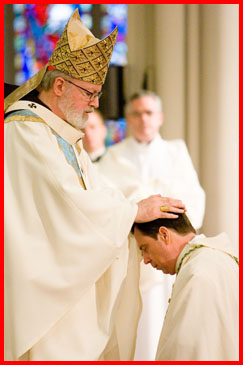
Imposing hands on Bishop Hennessey’s head …
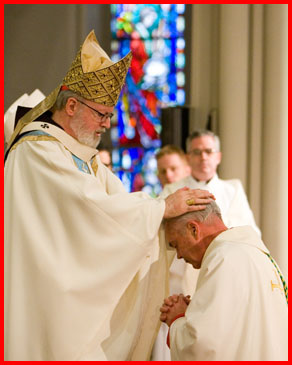
… and Bishop Dooher’s
For this reason, there are traditionally three bishops consecrating the new bishops to guarantee the validity of the sacrament. At the ordination on Dec. 12, auxiliary Bishops Emilio Allu�, Walter J. Edyvean and Francis X. Irwin as well as retiring Bishop John P. Boles were the co-consecrators. So much is at stake for this sacrament to be valid and for the apostolic succession, this gift that has come to us from Christ through the apostles through generations of bishops.
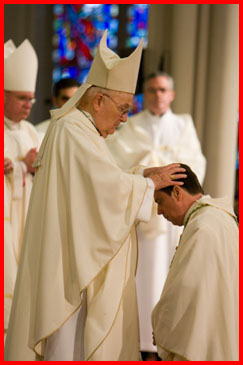
Bishop Boles co-consecrates the ordination
We have genealogies of the bishops, which are traced back. My own genealogy is through Bishop Harper, the Redemptorist bishop who ordained me in the West Indies. He had been ordained by the bishop of Brooklyn, who had been ordained by the nuncio, who had been ordained by another bishop, who had been ordained by St. Pius X, the pope � and so on and so forth. We know that this chain is an unbroken chain of apostolic succession that goes back in the Church and is very important to us.
Most Catholics never have the opportunity to attend the ordination of a bishop. We were so happy that Boston Catholic Television was there broadcasting it for people to watch at home. I know they repeated the broadcast a couple of times. Also, The Pilot has done a wonderful job with their special issue on the bishops and their coverage of the ordination. You can view much of their coverage including photos and even a recording of my homily at their website, www.TheBostonPilot.com.
After the ordination we had a reception at St. John�s Seminary in Brighton. There were over 1,600 people came, and we were so pleased to have that many people visit our seminary. I was also glad that we were able to have mariachis for the reception. Actually, I met them when I went to the pig roast for the young adults at St. John Chrysostom Parish in West Roxbury. Last summer the Young Adult Ministry had organized a wonderful pig roast, and they had entertainment for the young people. Among the entertainers were these group of mariachis, so I told them �Give me your card, you�ll be hearing from us.� I was hoping that they would be able to come to the Mass, but they were only able to become to the reception. It was a big hit with the people who really enjoyed having them there.
Family, friends and parishioners greeted the new bishops at St. John’s Seminary
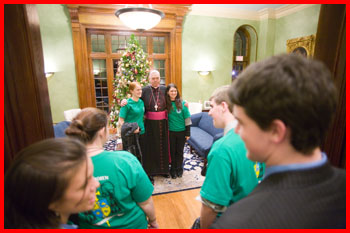
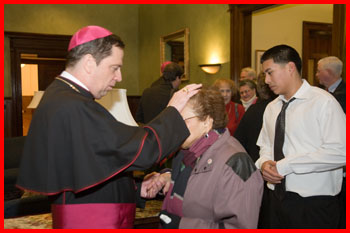
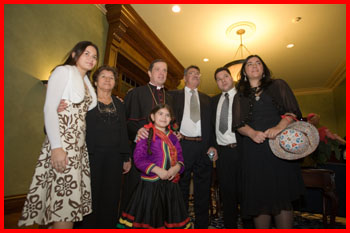
The Friday before the ordination I had the opportunity to visit my prior Diocese of Palm Beach because I was invited to be part of the 75th anniversary of the Agrupacion Catolica Universitaria in the neighboring Archdiocese of Miami. The Agrupacion is a Christian life community, founded in Cuba by a Jesuit, Father Rey de Castro, at a Jesuit school in the suburbs of Havana called Colegio de Belen where he was the principal.
After the revolution, many agrupados came to the United States. Father Amando Llorente, a Spanish Jesuit, continued the work here for over 50 years as their chaplain. I have been associated with them for about 40 years since the time that I was in the seminary. When I became the director of the Centro Catolico in Washington D.C., it was the agrupados, their wives and families that were my support group. A group of volunteers � doctors, dentists, teachers and social workers � helped us to work with the thousands of undocumented Hispanics who were pouring into Washington in the early 70s because of the wars in Central America.
The Agrupacion is a wonderful organization that has formed very strong families, and out of those families have come many vocations. In the 75 year history of the Agrupacion, they have ordained 48 members. Many of them I have ordained myself, so I was very honored to be asked to be part of their 75th celebration that was at the Gesu, the Jesuit church in Miami. As part of the ceremony several men made their consecrations and became congregantes in the Agrupacion.
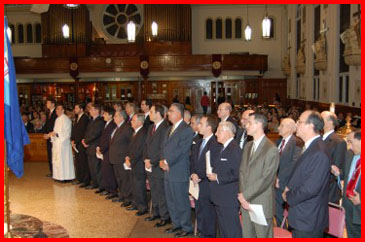
The new congregantes and their “padrinos” (Godfathers)
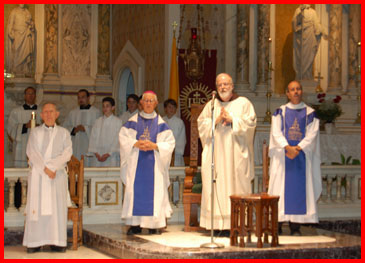
From left to right: Father Amando Llorente, Bishop Agustin Roman,
myself and Father Miguel Jesus Zaglul, SJ
The church was filled with people. Many of the agrupados and their families were from Washington and had worked with me.This is the text of my homily at the Mass:
Hoy los Nicarag�enses se saludan con la hermosa frase: �Quien causa tanta alegria? … �La Concepci�n de Mar�a! Hoy nos alegramos por la Inmaculada y por estas fiestas de los 75 a�os de la Agrupaci�n Cat�lica Universitaria. Mi papa quer�a que yo fuera Jesuita � eso no fue mi destino. Pero como arzobispo de Boston, tengo 300 Jesuitas en mi di�cesis, mas que el Papa tiene en Roma. Siempre digo a mis amigos Jesuitas que hay 36 cr�teres en la luna que llevan nombres de Jesuitas. En cambio se ha nombrado solo una taza de caf� por los capuchinos. Sin embargo, es un buen caf�.
El hijo de San Ignacio que m�s quiero y admiro y que es la raz�n que todos estamos aqu�, es el Padre Amando Llorente, S.J. El ha dirigido la Agrupaci�n por m�s de 50 a�os. Su visi�n, compromiso y entusiasmo han contagiado varias generaciones de agrupados y sus familias. Hoy felicitamos a los nuevos congregantes que pronto pronunciaran sus promesas.El carisma, la gracia especial que Dios dio al Padre Rey de Castro ha enriquecido la Iglesia.
La comuni�n que existe entre los agrupados y sus familias es una cosa bell�sima. S�lo de la comunidad de Washington han salido muchas vocaciones al sacerdocio y a la vida religiosa: Padre Ignacio Lazaga; Fray Emilio Biosca, Sor Maria Jose Biosca, Padre Ramon�n Dom�nguez, Padre Tim Galvan, Hermano Jose Trujillo y Padre Rafael Juantorena.
En total, 48 sacerdotes han salido de la A.C.U., pero la vocaci�n al matrimonio, y ser padre de familia han sido la gran aportaci�n de la espiritualidad de la A.C.U.La Agrupaci�n tambi�n ha dado m�rtires a la Iglesia �nuestros hermanos que entregaron sus vidas para testimoniar su amor y lealtad a Cristo y la Iglesia.Durante 75 a�os, generaciones de j�venes y hombres han vivido esta vocaci�n agrupacional y mariana de ser hombres seg�n el plan de Dios, viviendo la rica espiritualidad ignaciana de los ejercicios, participando en una comunidad basada en los ideales del evangelio.
De la consagraci�n de los agrupados han salido familias unidas con lazos de amistad y un amor profundo a Cristo y su Iglesia. La ciencia, la oraci�n, el servicio que se pregonan en el himno de la agrupaci�n.Desde los a�os 60, hace casi 40 anos que he estado estrechamente ligado a la A.C.U., primeramente cuando era seminarista capuchino estudiando espa�ol para prepararme a ir a las misiones. Pero cuando mi misi�n resulto ser Washington, fueron los hermanos de la A.C.U. y sus esposas los que me apoyaron e hicieron posibles las obras del Centro Cat�lico Hispano.
Cuando empec� como director, el presupuesto era de mil d�lares por mes para pagar el alquiler, la monja, la secretaria, mi comida � lo que sobraba gast� en frivolidades y caprichos. En el Centro Cat�lico trabajaban conmigo Pepe Trujillo, V�ctor Armengol, Ricardo Planos, Octavio Ledon y Manela Diez. Seco Cardenas y Eduardo Azcarate participaron en la Junta de Directores. Eladio Armengol, Jorge Forcada, Rafi Madan, Emilio Biosca, los doctores Roca, Roberto Lavin y sant�simos otros que no puedo nombrar aqu�. Sin ellos jam�s se hubiera podido lanzar la gran obra del Centro Cat�lico que siguen sirviendo millares de inmigrantes pobres, desamparados hoy en d�a.
El Padre Llorente siempre animaba esta esmerada participaci�n en las obras del Centro Cat�lico de parte de los agrupados. En Washington en aquellos d�as, casi todos los hispanos, eran indocumentados, por eso acudieron a la Iglesia para todo � vivienda, servicio de salud, trabajos, clases de ingles, cuidado pastoral y todo.Los agrupados ayudaron hasta con el programa de Radio Encruajada que presentabamos todos los domingos.
La idea original era invitar al publico que nos escribiera sus preguntas. Los agrupados escrib�an preguntas y respuestas sobre cuestiones morales, religiosas y las le�a, procurando que los radioescuchas escribieran cartas con sus preguntas. Nadie escribi�, y los agrupados segu�an inventando preguntas dignas de una telenovela. Un dia yo estaba viajando en el autob�s por el barrio latino. Una se�ora se sent� a lado m�o y me dijo: �Padre, su programa de radio es muy interesante, pero esos cubanos, que problemazos tienen.�
Un d�a en el Centro Cat�lico llegue temprano y encontr� a la Hermana Manuela tan contenta porque acababa de enviar varios autobuses llenos de trabajadores indocumentados a responder a un trabajo misterioso. Alguien hab�a llamado por la ma�ana a pedir a todos los trabajadores que pudi�ramos reunir. La persona dijo que no importaba si ten�an papeles y que iba apagarles en efectivo. Me entro p�nico pensando que tal vez fuera una trama de la �migra.� Resulto que les contrat� para haber una manifestaci�n frente a la Casa Blanca a favor del Sha de Ir�n �porque los latinos podr�n pasar por Iran�es.�
En el mundo de hoy muchos se enga�an por las apariencias. Como los estudiantes franceses de la Sorbona que subieron al tren en Paris y entraron en el compartimento donde un anciano sentado en el rinc�n rezaba silenciosamente su rosario. Uno de los estudiantes vislumbr� el rosario y susurr� a su compa�ero: �Mira a este pobre viejo supersticioso y est�pido. Horrorizado, su amigo le replico: �C�llate, ese hombre es el Doctor Luis Pasteur, el cientifico mas brillante de Francia y tal vez del mundo.� El pobre estudiante no pod�a entender porque Luis Pasteur rezaba un rosario. Nosotros si lo sabemos.
Alexander Solzhenitsyn dijo que una conversaci�n que hab�a escuchado de ni�o siempre se qued� grabada en su mente. Un grupo de aldeanos ancianitos estaban lamentando la suerte de su pa�s y dijeron que toda la opresi�n, los gulag, las masacres, las torturas de presos pol�ticos, resultaron porque la gente se olvid� de Dios.
Olvidarse de Dios es peligroso porque s�lo descubriendo qui�n es Dios, descubrimos quienes son nosotros, porqu� estamos aqu�, y que tenemos que hacer con nuestras vidas. Tal vez una met�fora id�nea para captar la condici�n del hombre actual es la del Alzheimer Espiritual. El ser humano que se olvida de Dios, se olvida de su origen y su destino. Cuando nos olvidamos de Dios, vagamos sin rumbo, somos incapaces de lidiar con las circunstancias, nuestras relaciones con los dem�s empiezan a deteriorarse, y acabamos en un estado deplorable.
El mes pasado la revista inglesa, The Economist, nos dio indicaciones del porvenir de una sociedad que sufre de Alzheimer Espiritual. Hablando de la poblaci�n de Europa, el articulo dice que la tasa de natalidad de Europa en general, o sea de la Uni�n Europea es 1.4, que quiere decir que en cuatro a�os habr� mas muertes que nacimientos en Europa. En Italia y Espa�a la situaci�n es m�s grave aun con la tasa de natalidad de 1.2, que significa que en cuarenta a�os las sendas poblaciones de Italia y Espa�a se reducir�n a la mitad de la poblacion actual, y que el t�pico ciudadano no tendr� hermanos, ni primos, ni t�os. Ir�nicamente, mientras m�s prospero el pa�s, menos hijos tienen.
En los EEUU la poblaci�n sigue creciendo en parte seg�n el Economist porque los americanos son mas religiosos, y las Iglesias y congregaciones fomentan la vida familiar. Pero la creciente secularizaci�n de nuestra sociedad ya causa un Alzheimer Espiritual que nos pone en un camino que nos aleja de Dios y de nuestra conciencia de quienes somos.
El lema de la Agrupaci�n siempre me ha gustado aunque no es pol�ticamente correcto decir �Esto Vir� en un mundo muy sensible a los estragos causados por el machismo. Muchos podr�an interpretar �Esto Vir,� �Se Hombre,� como una exhortaci�n a la agresi�n, la violencia, desenfreno sexual, el desprecio de la mujer. Todo esto est� muy lejos del sano significado de esta devisa.
�Esto Vir� son palabras de la Biblia, del primer Libro de Reyes. David en su lecho de muerte dirige estas palabras a Salom�n, su hijo como su �ltimo testamento de un padre. Ten valor y se hombre � cumple los mandamientos del Se�or, haciendo su voluntad y cumpliendo sus leyes, decretos y mandatos. �Esto Vir.� Es imposible ser hombre a cabalidad, si nos olvidamos de que somos hijos de Dios hechos a su imagen y semejanza. Conociendo el plan de Dios y abraz�ndolo logramos ser hombres de verdad, hombres hechos y derechos que caminan en las sendas del Se�or en medio de un mundo que se ha olvidado de Dios y as� ofrece otra definici�n de Hombre.
Los Evangelios caracterizan a Maria como modelo de ser disc�pulo y la memoria de la Iglesia. Mucho de lo que reporta el Evangelio se estriba en entrevistas que Lucas y los dem�s evangelistas tuvieron con ella. Ella es testigo ocular de todos los misterios del Rosario. Ella es Madre de Cristo en la Anunciaci�n, madre de los disc�pulos en el Calvario, madre de la Iglesia en Pentecost�s.
En m�s de una ocasi�n, el Evangelio menciona que Maria guardaba y ponderaba todo esto en su coraz�n. Ella es el arca, ba�l de tesoros de la Iglesia. Juan Pablo II en su carta Apost�lica, El Rosario de la Virgen Maria, dice que: �Maria vive mirando a Cristo. Los recuerdos de Jes�s impresos en su alma, la han acompa�ado en todo momento.�
En la pelicula, �La Pasion,� la escena donde Jes�s cae debajo del peso de la Cruz y Mar�a experimenta un �flashback� y revive el episodio cuando Jes�s como ni�o se cay� y ella acudi� para consolarlo. Ciertamente es uno de las escenas m�s conmovedoras en la pel�cula.
Pero me atrevo a decir que lo que m�s ponderaba Maria en su coraz�n eran los grandes temas de nuestra fe.
Una vez preguntaron a Larry King que si el pudiera tener una entrevista con cualquier personaje de la historia, a quien escoger�a. Larry King respondio que el escoger�a a Jes�s Cristo. Luego le preguntaron �y que preguntar�a a Jes�s.� King dijo: �Yo preguntar�a a Jesus Cristo si de veras naci� de una virgen. Para mi la respuesta define toda la historia.�
Me hace pensar en mi te�logo preferido, Archie Bunker…Su yerno, Meathead, rega�a a Archie diciendlo: Acuerdate Archie, Jesus era judio. �Si, pero solo de parte de la mama.�
Jes�s es Dios, y eso define nuestra historia, nuestra humanidad, nuestro destino. Y esa verdad fue escrita en el cuerpo de Mar�a y su virginidad y su concepci�n inmaculada. Para Dios, no hay nada improvisado. Desde la eternidad nuestro Dios nos ha amado y en Mar�a tenemos el �ltimo preparativo para la venida de nuestro Mes�as, nuestro redentor. Mar�a es la Mujer de Adviento. El Evangelio de hoy presenta a Mar�a como la Nueva Eva, la madre de la humanidad.
Cuando Dios llam� a la puerta de la humanidad, es Mar�a en nombre de todos la que abre la puerta y responde que s� al Se�or �Hagase en mi seg�n tu palabra.� Mar�a no entend�a todo, tenia miedo, pero confiaba en el amor de Dios, y se entreg� a sus planes. El Cardinal O�Connor me hablo de su ordenaci�n de obispo. Me cont� que la Madre Teresa estaba all�, y al pasar cerca de ella en la procesi�n, ella le dijo: �D�le permiso a Dios (Give God permission).� El nunca se olvido de esa frase, y que bien dicha est�. Dios es amor, y el amor jam�s se coacciona.
Von Baltazar, el te�logo suizo que siempre inventa nuevos t�rminos teol�gicos, nos invento la expresion �kniende theologie,� �teolog�a de rodilla.� Describe el Fiat de Mar�a como el �Geschehenlassendes Ja� de Mar�a � para el juego de Scrabble ser�a una palabra sensacional. Quiere decir un s� que permite que algo suceda. El s� de Maria permiti� que sucediera el acontecimiento m�s grande en la historia de la creaci�n. Nuestro Dios se hizo nuestro hermano.
La �ltima palabra de Mar�a es mi divisa, el lema en mi escudo: �Haced lo que el os diga.� La primera palabra de Mar�a es su fiat, su s�. La �ltima palabra de Mar�a esta dici�ndonos a decirle que s� tambi�n, a obedecer la palabra de Dios, abrazando su voluntad. La �ltima palabra de Maria es semejante a la �ltima palabra de David � Ten valor y se hombre � �Esto Vir� siguiendo los caminos del Se�or, viviendo sus mandamientos y consejos. �Haced lo que el os diga� � y �Esto Vir� son la misma cosa.
Cuando decir que s� al Se�or � Cristo y su reino entra en nuestra historia y el mundo se hace mejor.
La Agrupaci�n ha ense�ado a muchos j�venes a ser hombres de verdad, hombres seg�n el bello plan de Dios. Descubriendo quien es Dios, descubrimos quienes somos nosotros y porque estamos aqu� y que tenemos que hacer con nuestras vidas.
Hoy le doy Gracias a Dios por este don y carisma que ha formado tantas generaciones de hombres cat�licos y fortalecido tantas familias.
Me siento muy honrado ser parte de la Agrupaci�n donde he encontrado verdaderos amigos y hermanos en Cristo. Enhorabuena, y gracias de coraz�n.
By happy coincidence the next day in my former Diocese of Palm Beach, they were rededicating the cathedral, and so I was able to spend the morning with them at St. Ignatius Cathedral, where Bishop Gerald Barbarito has done a wonderful job of renovating the cathedral. It�s really, really beautiful the way that it came out. I participated in the liturgy that they had there, and it was wonderful to see so many of the priests, deacons and the people from my former diocese. It also gave me a chance to be with Claire O�Malley and a lot of old friends.
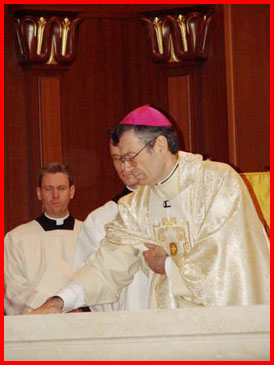
Bishop Barbarito consecrates the altar
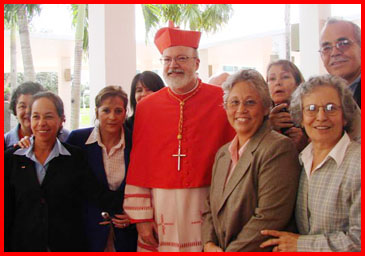
It was great to see familiar faces
That afternoon we returned to Boston on an early evening flight. The pilot told us that if we turned off the lights on the plane, we would be able to see the space shuttle Discovery taking off from Kennedy Space Center. We were all shocked because it was so visible. The light was so bright! It was a magnificent sight. If we had been much closer, we would have been able to wave to the astronauts.

Seeing the shuttle launch was breathtaking
Back in Boston on Sunday, I was very happy to be a part of the 150th anniversary of St. Patrick Parish in Brockton. The church, which was founded 150 years ago by Irish immigrants, is still fulfilling that wonderful mission of receiving newcomers into the community. It is now a very heavily Hispanic parish. Father Jose Abalon is doing a wonderful job there.
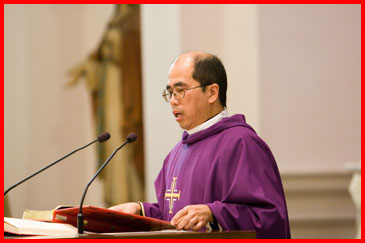
Father Abalon proclaims the Gospel
I was so happy that we were joined by a number of priests for the Mass, among them Father Fred O�Brien, who actually is responsible for the magnificent renovations of the church. He was able to renovate the church in a very creative way and at the same time preserve the original beauty of the baldacchino, the stations of the cross and the other very historic elements of the church.
Also concelebrating were Fathers John Doyle, Joseph Gaudett, George Szal, Francis Cloherty, James Flavin and Daniel Sheehan.
The music was very enthusiastic, and it was a bilingual celebration. It�s a parish where the English and the Spanish-speaking community are very well integrated. There�s a wonderful sense of parish and of community. After the Mass we enjoyed a wonderful lunch in the parish hall and a big cake celebrating the 150 years of the parish�s history.
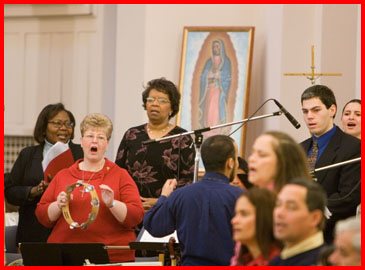
The choir was wonderful
�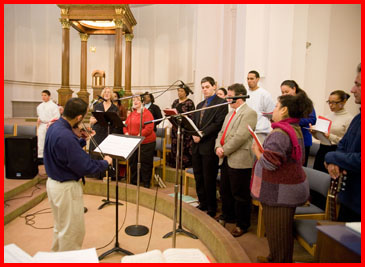
�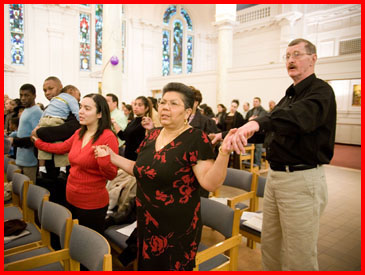
The parish has a great diversity
Sunday evening I was happy to be able to return to St. Edward the Confessor Parish in Medfield to celebrate Mass there once again. They had a wonderful youth choir, and the church was filled with young families, including 140 members of their confirmation class who were present for the liturgy. The pastor, Father Leroy Owens, is doing such a wonderful job with his parish.
The photo of the week:

Thanks to our friends at NASA for supplying the photos of last Saturday’s launch
I hope you all have a wonderful coming week, and I look forward to writing to you next Friday.
Yours in Christ,
Cardinal Se�n
�
�
�
